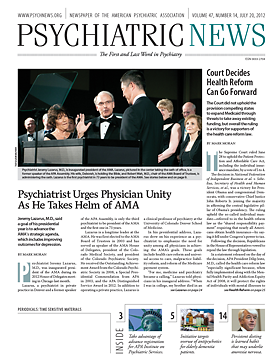Persistent dieting associated with anorexia nervosa (AN) may be a learned habit that becomes ingrained over time and extraordinarily difficult to break in adults who have had the disorder for many years.
So suggested Timothy Walsh, M.D., Ruane Professor of Pediatric Psychopharmacology at Columbia University, in a lecture at APA’s annual meeting in Philadelphia in May titled “The Persistent Enigma of Anorexia Nervosa.”
Walsh proposed a new conceptual model that attempts to explain why compulsive dieting—despite its potentially deadly consequences—is remarkably durable. Drawing on learning theory, Walsh suggested that dieting, initially rewarding, becomes a fixed habit that occurs automatically and involves a structured behavioral sequence prone to be elicited by a range of stimuli.
“Research has worked out to an impressive degree how humans learn behavior patterns and how those patterns turn into habits,” Walsh said. “What I have learned from studying that research is that humans pick up a new behavior because it is rewarding. But if you over-train the behavior, in time a person will continue the behavior even when the reward is not consistently received.”
He said that during adolescence several factors—including the cultural emphasis on thinness among women—make persistent dieting that leads to thinness rewarding and thereby “overtrain” the brain. “Over time the behavior becomes engraved on the brain,” Walsh said. “It’s this that makes it so hard to eradicate.”
Walsh also reviewed proposed changes to criteria for anorexia nervosa in DSM-5. These include editorial changes to existing criteria related to body weight and “fear of getting fat.”
Walsh said there are patients who meet all criteria for anorexia nervosa but do not explicitly acknowledge a fear of getting fat, so the newly proposed criteria say “Intense fear of gaining weight or becoming fat or persistent behavior that interferes with weight gain, even though at a significantly low weight.”
But the most significant proposal to the AN diagnostic criteria is elimination of amenorrhea as a requirement for diagnosis. In an interview with Psychiatric News for a report on proposed changes to DSM-5 criteria, Walsh said, “A literature review yielded a body of research showing that women who meet all the criteria for anorexia nervosa but still report some menstrual activity are virtually identical in terms of clinical impairment and treatment response” (Psychiatric News, January 6).
In his annual meeting lecture, Walsh also reviewed data on treatment efficacy. He noted that a large body of research now supports the efficacy of the so-called “Maudsley method.”
According to the Web site Maudsley Parents
(www.maudsleyparents.org) the therapy is “an intensive outpatient treatment where parents play an active and positive role to help restore their child’s weight to normal levels expected given their adolescent’s age and height, then hand control over eating back to the adolescent and encourage normal adolescent development through an in-depth discussion of these crucial developmental issues as they pertain to their child.”
Walsh presented data from several studies showing higher rates of full and partial recovery using the Maudsley method rather than traditional individual therapy.
Yet he noted that there are not comparably effective treatments for adults. “Youngsters who develop AN, especially if they get a Maudsley intervention, do generally well over time. In contrast, on average, the treatment of older people who have had the disease longer—even only five or 10 years longer—is much more challenging and difficult.
“We don’t have treatments for adults anywhere near as good as we have for adolescents,” he said. “The question that I have been led to wonder about is how once this disorder gets established, it becomes so persistent and so refractory to treatments that you would think would be more effective than they are.”
Walsh said the model of AN as a learned behavior helps explain why teenagers who are treated for the disorder do so much better than adults. “As teenagers they have had less time to practice the habit, so it is less well established and less engraved in neural circuits,” he said.


